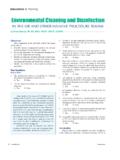Transcription of Cleaning in Healthcare Facilities - …
1 Cleaning in Healthcare FacilitiesReducing human health effects and environmental impactsA P R I L 2 0 0 9H E A L T H C A R E R E S E A R C H C O L L A B O R A T I V EA U T H O R S : Pia Markkanen, ScD, Margaret Quinn ScD, CIH,Catherine Galligan, MSc, Anila Bello, ScDHealth Care Without Harm has initiated a research collaborative coordinated by faculty of the University of Illinois at Chicago School of Public Health, with support from the Pioneer Portfolio of the Robert Wood Johnson Foundation, aimed at stimulating collaborative research around health and safety improvements in health care. This collaborative is designed to increase the evidence base concerning the human health and environmental impacts of materials, products and practices within health care. In partnership with the Global Health and Safety Initiative (GHSI), the Research Collaborative is engaged in research directed at the intersection of environmental, patient, and worker safety issues related to building and operating health care institutions.
2 This paper is part of a series in which the Collaborative will provide research and analysis of the health and environmental impacts of select groups of this new generation of materials and facilitate sharing of experiences on installation, maintenance and A B L E O F C O N T E N T SAcknowledgements ..2 Executive Summary ..3I. Introduction ..6II. Purpose and development of this document ..7 III. Background ..8 Definitions for Cleaning and disinfection ..8 Cleaning and potential harms to health and the environment ..8 Significance of Cleaning in the Healthcare sector ..9 The Cleaning system ..10IV. Health and environmental hazards: scientific and professional evidence ..11 Human health effects ..11 Exposure assessment efforts ..12 Environmental impacts ..13V. Healthier and more environmentally friendly Cleaning for Healthcare ..14 What is green Cleaning ? ..14 Benefits of green Cleaning and examples of efforts.
3 14 Cleaning , disinfecting, and antimicrobials products ..15VI. Systems approach ..17 SHP experience with a systems approach to changing practices in hospitals ..18 Practice Greenhealth approach ..20 Management and the team ..20 VII. Green movements in the Healthcare sector ..21 LEED for Healthcare ..21 Green cleaner certification programs ..21 VIII. Moving upstream towards non-chemical alternatives ..23IX. Conclusions and recommendations ..25 List of references ..27 Appendix A: Examples of hazardous ingredients in conventional Cleaning products ..31 Appendix B: Information on green Cleaning efforts in Healthcare Facilities ..34 Appendix C: Selected sources for choosing industrial green Cleaning products ..36 AcknowledgementsThis paper has been jointly commissioned by Health Care Without Harm and the Global Health and Safety Initiative. It has been developed by the research team at the Sustainable Hospitals Program (SHP), a pro-gram of the Lowell Center for Sustainable Production (LCSP) at the University of Massachusetts Lowell.
4 The authors gratefully acknowledge the following persons in the development and review of this document: Cathy Crumbley, Program Director, the Lowell Center for Sustainable Production; Judene Bartley (MSc, MPH, CIC) Vice President of the Epidemiology Consulting Services, paper was generously funded from the Pioneer Portfolio of the Robert Wood Johnson & Layout by Kieran Daly & Parisa Damian of Winking Fish. The Sustainable Hospitals Program The Sustainable Hospitals Program (SHP) was initiated at the University of Massachusetts Lowell in 1998 to pro-vide science-based technical guidance to the Healthcare industry for selecting products and practices that promote occupational and environmental health and safety. Based within the Lowell Center for Sustainable Production (LCSP), the SHP aims to fully integrate occupational and environmental health and safety into comprehensive solutions for more sustainable Healthcare .
5 The SHP and LCSP have a research program to promote safer and more environmentally sound Cleaning materials and practices. This work has the following components: 1. Conducting exposure assessments. Identifying what workers, patients and other building occu-pants are exposed to is the first step in improving Cleaning . The SHP has an occupational/environ-mental hygiene laboratory and field equipment and has developed the technical expertise to measure exposures from Characterizing the health effects of Cleaning products. Epidemiologists on our team have expe-rience conducting field studies as well as in con-ducting systematic reviews of the health literature. The LCSP collaborated with Health Care Without Harm to write Risks to Asthma Posed by Indoor Health Care Environments: A Guide to Identify-ing and Reducing Problematic Exposures .13. Assessing the effectiveness of new Cleaning products. The Surface Solutions Laboratory (SSL) of the LCSP-UMass Lowell sister organization, The Toxic Use Reduction Institute (TURI), conducts effi-cacy testing on Cleaning products and promotes the use of green TURI offers an interactive, free-of-charge online database on surface cleaning5 called CleanerSolutions to help manufacturers find safer Cleaning alternatives that perform as well as the products based on hazardous chemicals.
6 It also provides online information including Ten Ways to Find Safer and Greener Cleaners .6 The TURI SSL is certified by Green Seal the US eco-labeling organization to test the efficacy of green products. 4. Conducting field studies to assist Healthcare Facilities in implementing alternative Cleaning products and practices. Over the past decade, the SHP has used participatory processes for imple-menting healthier and more sustainable workplace programs through the Pollution Prevention-Occu-pational Safety and Health alternatives assessment strategy (P2 OSH).7 5. Translating sound environmental practices into social policy and regulations. We work with Healthcare providers and insurers to improve the provision of environmental remediation for asthma triggers in the Another example of the translation of research to practice is a project with a Brazilian women s organization to educate Brazil-ian domestic cleaners about the hazards of house-hold cleaners and help them to replace these with less toxic cleaners made from safer Center of Sustainable Production University of Massachusetts LowellOne University Avenue Lowell, MA in Healthcare Facilities : Reducing human health effects and environmental impacts3E X E C U T I V E S U M M A R YCleaning of Healthcare Facilities is performed for medical and cultural reasons.
7 maintaining an environment with a low pathogenic burden is essential for avoiding complications during the care and recuperation of patients. A healthy, safe, and aesthetically pleasing space with clean surfaces is comforting to patients and their families by giving an impression of good quality care without additional health hazards. While Cleaning is important in all economic sectors, it serves the Healthcare industry the dual functions of: (i) surface cleanliness, and (ii) infection prevention and control. As such, Healthcare settings require intensive and frequent Cleaning with a wide range of products. This document summarizes the main health and environmental impacts related to conventional surface Cleaning , describes a systems approach for designing and implementing healthier and environmentally friendlier Cleaning strategies for the Healthcare sector, and indicates areas where future research and policy initiatives are needed.
8 Cleaning for infection prevention and controlImprovements in the health and environmental impacts of Cleaning must be considered along with concerns for infection prevention and control. Health-care settings are engaged in a battle against Healthcare -associated infections (HAIs).12 The importance of infection prevention and control is increasing due to rapidly developing strains of multi-drug resistant organisms (MDROs) that can result in serious illness and even death in workers and patients. In 2002, US hospitals reported about million HAIs, associated with almost 99,000 The proportion of S. aureus bloodstream infections due to MRSA increased significantly from 27% in the period of 1990-1994 to 54% during 2000-2004 (P > .001).13 Studies have estimated that antimicrobial drug-resistant infections have increased direct costs to society by 30%-100%.14 The excess cost of a single MRSA infection compared with a methicillin-sensitive S.
9 Aureus infection was estimated to range from $3,000 to $25, This sug-gests that MRSA costs the Healthcare system (patients and Healthcare Facilities ) an estimated additional $830 million to $ billion in 2005 excluding the indirect costs related to psychological suffering of patients and their family members as well as lost work time spent in the Potential health and environmental impacts of Cleaning chemicalsMany hospitals have increased the use of Cleaning and disinfecting products to address HAIs as well as other infection prevention and control concerns. However, conventional Cleaning products and disinfectants bring a host of other health hazards despite their capac-ity to fight against MDROs. This document provides a literature review of Cleaning products and their adverse effects on human health and the environment. Conventional Cleaning products are complex mixtures of chemical ingredients. Many of these ingredients are known or suspected to be associated with asthma and Cleaning in Healthcare Facilities : Reducing human health effects and environmental impacts4other respiratory disorders.
10 Some others are associated with dermatitis, endocrine and neurologic effects, and cancer. However, many ingredients have not been tested and so their effects are still unknown. Potentially harmful exposures from Cleaning are a function of mul-tiple factors, including: (i) the chemical characteristics of the Cleaning product, (ii) the physical characteristics (aerosols vs. liquids for example), (iii) the characteris-tics of Cleaning tasks (spraying vs. mopping), and (iv) the characteristics of the built environment (ventila-tion, room size).15 There is evidence that some Cleaning product ingredients harm the environment. They may bioaccumulate in plants and animals, damage aquatic ecosystems, and pollute indoor air, outdoor air, and drinking water Greener cleaningConcerns about adverse human and environmental health effects of conventional Cleaning products have led to the development of green cleaners. Some green cleaners may reduce human health and environmen-tal effects as well as reduce costs.




